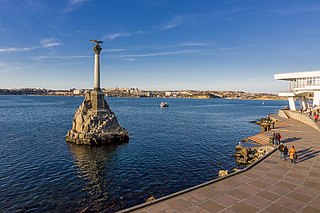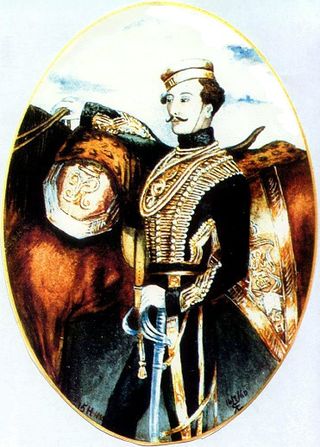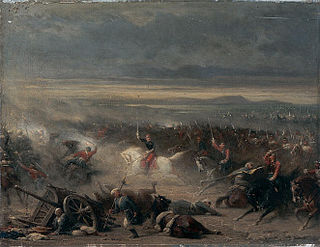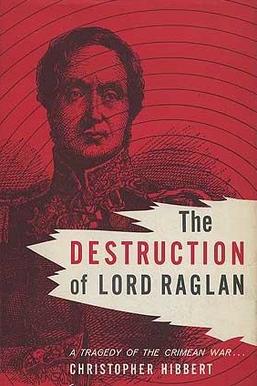Related Research Articles

The Crimean War was fought from October 1853 to February 1856 between Russia and an ultimately victorious alliance of the Ottoman Empire, France, the United Kingdom and Sardinia-Piedmont.

Sevastopol, sometimes written Sebastopol, is the largest city in Crimea, and a major port on the Black Sea. Due to its strategic location and the navigability of the city's harbours, Sevastopol has been an important port and naval base throughout its history. Since the city's founding in 1783 it has been a major base for Russia's Black Sea Fleet, and it was previously a closed city during the Cold War. The total administrative area is 864 square kilometres (334 sq mi) and includes a significant amount of rural land. The urban population, largely concentrated around Sevastopol Bay, is 479,394, and the total population is 547,820.

The Battle of the Alma was a battle in the Crimean War between an allied expeditionary force and Russian forces defending the Crimean Peninsula on 20 September 1854. The allies had made a surprise landing in Crimea on 14 September. The allied commanders, Maréchal Jacques Leroy de Saint-Arnaud and Lord Raglan, then marched toward the strategically important port city of Sevastopol, 45 km (28 mi) away. Russian commander Prince Alexander Sergeyevich Menshikov rushed his available forces to the last natural defensive position before the city, the Alma Heights, south of the Alma River.

The Battle of Inkerman was fought during the Crimean War on 5 November 1854 between the allied armies of Britain and France against the Imperial Russian Army. The battle broke the will of the Russian Army to defeat the allies in the field, and was followed by the siege of Sevastopol. The role of troops fighting mostly on their own initiative due to the foggy conditions during the battle has earned the engagement the name "The Soldier's Battle."

The Battle of the Chernaya was a battle by the Chyornaya River fought during the Crimean War on August 16, 1855. The battle was fought between Russian troops and a coalition of French, Piedmontese and Ottoman troops. The Chyornaya River is on the outskirts of Sevastopol. The battle ended in a Russian retreat and a victory for the French, Piedmontese and Turks.

Crimea is a peninsula South of mainland Ukraine, on the northern coast of the Black Sea, that has been owned by Russia since 2014. It has a population of 2.4 million. The peninsula is almost entirely surrounded by the Black Sea and the smaller Sea of Azov. The Isthmus of Perekop connects the peninsula to Kherson Oblast in mainland Ukraine. To the east, the Crimean Bridge, constructed in 2018, spans the Strait of Kerch, linking the peninsula with Krasnodar Krai in Russia. The Arabat Spit, located to the northeast, is a narrow strip of land that separates the Sivash lagoons from the Sea of Azov. Across the Black Sea to the west lies Romania and to the south is Turkey.

Field Marshal FitzRoy James Henry Somerset, 1st Baron Raglan,, known before 1852 as Lord FitzRoy Somerset, was a British Army officer. When a junior officer, he served in the Peninsular War and the Waterloo campaign, latterly as military secretary to the Duke of Wellington. He also took part in politics as Tory Member of Parliament for Truro, before becoming Master-General of the Ordnance.

The Battle of Balaclava, fought on 25 October 1854 during the Crimean War, was part of the Siege of Sevastopol (1854–55), an Allied attempt to capture the port and fortress of Sevastopol, Russia's principal naval base on the Black Sea. The engagement followed the earlier Allied victory in September at the Battle of the Alma, where the Russian General Menshikov had positioned his army in an attempt to stop the Allies progressing south towards their strategic goal. Alma was the first major encounter fought in the Crimean Peninsula since the Allied landings at Kalamita Bay on 14 September, and was a clear battlefield success; but a tardy pursuit by the Allies failed to gain a decisive victory, allowing the Russians to regroup, recover and prepare their defence.
Balaklava is a settlement on the Crimean Peninsula and part of the city of Sevastopol. It is an administrative center of Balaklava Raion that used to be part of the Crimean Oblast before it was transferred to Sevastopol Municipality. Population: 18,649 .

Louis Edward Nolan was a British Army officer and cavalry tactician best known for his role and death in the Charge of the Light Brigade during the Crimean War. Born to a minor diplomatic official and his wife, Nolan was educated at the Austrian Inhaber Pioneer School at Tulln, where he was noted as an enthusiastic horseman and military theorist. After early graduation he was commissioned as a subaltern in the 10th Austrian Hussar regiment, serving in Austria, Hungary and on the Polish frontier, where he again became known for his horsemanship and was promoted to senior lieutenant. Due to the nepotism inherent in the Austro-Hungarian armed forces, Nolan succeeded in transferring to the British Army as a Cornet in the 15th Light Dragoons.

The siege of Sevastopol lasted from October 1854 until September 1855, during the Crimean War. The allies landed at Eupatoria on 14 September 1854, intending to make a triumphal march to Sevastopol, the capital of the Crimea, with 50,000 men. Major battles along the way were Alma, Balaklava, Inkerman, Tchernaya, Redan, and, finally, Malakoff. During the siege, the allied navy undertook six bombardments of the capital, on 17 October 1854; and on 9 April, 6 June, 17 June, 17 August, and 5 September 1855.

Balaclava is an inner suburb in Melbourne, Victoria, Australia, 7 km south-east of Melbourne's Central Business District, located within the City of Port Phillip local government area. Balaclava recorded a population of 5,392 at the 2021 census.

Inkerman is a Ukrainian city in the Crimean peninsula. It is de facto within the federal city of Sevastopol within the Russian Federation, but de jure within Ukraine. It lies 5 kilometres east of Sevastopol, at the mouth of the Chernaya River which flows into Sevastopol Inlet. Administratively, Inkerman is subordinate to the municipality of Sevastopol which does not constitute part of the Autonomous Republic of Crimea. Population: 10,348 .

The Battle of Eupatoria occurred on 17 February 1855 during the Crimean War when the army of the Russian Empire unsuccessfully attempted to capture the Crimean port city of Eupatoria held by the forces of the Ottoman Empire.

The siege of Kars was the last major operation of the Crimean War. In June 1855, attempting to alleviate pressure on the defence of Sevastopol, Emperor Alexander II ordered General Nikolay Muravyov to lead his troops against areas of Ottoman interest in Asia Minor. Uniting disparate contingents under his command into a strong corps of 25,725 soldiers, 96 light guns, Muravyov decided to attack Kars, the most important fortress of Eastern Anatolia.

The recorded history of the Crimean Peninsula, historically known as Tauris, Taurica, and the Tauric Chersonese, begins around the 5th century BCE when several Greek colonies were established along its coast, the most important of which was Chersonesos near modern day Sevastopol, with Scythians and Tauri in the hinterland to the north. The southern coast gradually consolidated into the Bosporan Kingdom which was annexed by Pontus and then became a client kingdom of Rome. The south coast remained Greek in culture for almost two thousand years including under Roman successor states, the Byzantine Empire, the Empire of Trebizond, and the independent Principality of Theodoro. In the 13th century, some Crimean port cities were controlled by the Venetians and by the Genovese, but the interior was much less stable, enduring a long series of conquests and invasions. In the medieval period, it was partially conquered by Kievan Rus' whose prince Vladimir the Great was baptised at Sevastopol, which marked the beginning of the Christianization of Kievan Rus'. During the Mongol invasion of Europe, the north and centre of Crimea fell to the Mongol Golden Horde, and in the 1440s the Crimean Khanate formed out of the collapse of the horde but quite rapidly itself became subject to the Ottoman Empire, which also conquered the coastal areas which had kept independent of the Khanate. A major source of prosperity in these times was frequent raids into Russia for slaves.

The Grand Crimean Central Railway was a military railway built in 1855 during the Crimean War by Great Britain. Its purpose was to supply ammunition and provisions to Allied soldiers engaged in the Siege of Sevastopol who were stationed on a plateau between Balaklava and Sevastopol. It also carried the world's first hospital train.

The Destruction of Lord Raglan: A tragedy of the Crimean War, 1854–55 is a non-fiction historical work by Christopher Hibbert, originally published by Longman in 1961. The work is a portrait of Lord Raglan, commander-in-chief of British forces during the Crimean War.

Kalamita Bay, also known as Gulf of Kalamita, is a bay and a gulf in the Black Sea south of Yevpatoria, Crimea, Ukraine. Kalamita was likewise a name used for Inkerman.
References
- ↑ Orlando Figes, Crimea, Penguin, 2011, pp 229, 287
- ↑ Christopher Hibbert, The Destruction of Lord Raglan, Pelican, 1961, p 132
- ↑ Trevor Royle, Crimea, Abacus, 1999, p 299
- ↑ Orlando Figes, Crimea, Penguin, 2011, p 287